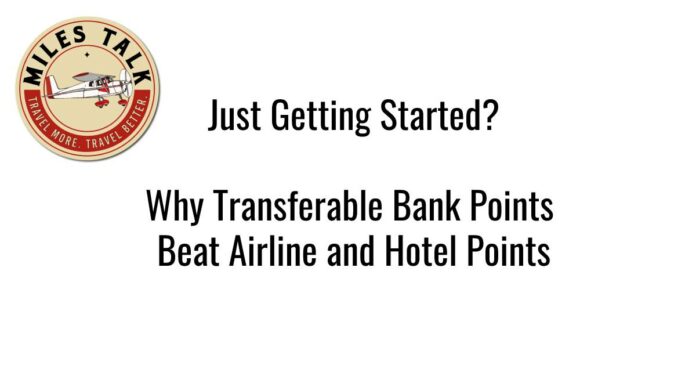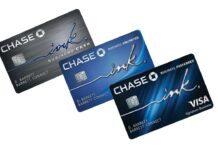
If you are brand new to the miles and points game, you may be quite overwhelmed by the options you have. You hear about a credit card that has points and then another one earns miles for one airline or another. It’s overwhelming how many there are to choose from.
Commonly, someone’s first travel rewards credit card is a co-brand card with either an airline they fly a lot or a hotel chain they stay at a lot. It makes sense from the standpoint that they have an affinity for and loyalty to that brand.
But when it comes to spending on that credit card, it is very rarely the best move compared to a bank credit card offering transferable points, meaning points that can be moved from your credit card account to a variety of different airline frequent flyer programs or hotel frequent guest programs. You even have the option to redeem transferable bank points for travel (sometimes valuing points even higher than a penny each) via the bank travel portals. This provides less value than transferring points in most cases, however, some people do prefer the simplicity. Airline cards would not offer this option.
In my book, MilesTalk: Live Your Wildest Travel Dreams Using Miles and Points, Chapters 2, 8, and 9 all cover transferable points, why they matter, and why they are better than earning an airline mile or hotel point for your spend.
A transferable bank point is one that is earned via a credit card that earns Chase Ultimate Rewards, American Express Membership Rewards, Citi ThankYou points, or Capital One Miles. Examples are the Chase Sapphire Preferred Card, the Citi Premier, the American Express Gold Card, and the Capital One Venture X.
Examples of co-branded credit cards include the American Airlines AAdvantage Credit Cards, United Credit Cards from Chase, and the Delta Credit Cards from American Express as well as hotel co-brands like the Marriott Bonvoy Credit Cards from American Express and Chase.
While there are times that it makes sense to have a co-branded credit card for your favorite airline or hotel, it is almost never the first card you should get nor the card you should put sizable spend on.
In this article
Transferable Points = Options
This hobby is all about options.
If one airline doesn’t have award space, another might.
For example, if you have Delta SkyMiles and there are no good options to get where you are going but United does, Chase Ultimate Rewards points can transfer to United 1:1. Likewise, if you needed Delta SkyMiles, you could transfer to Delta from American Express Membership Rewards points. If you stay at a range of hotels, you may not want to be locked into one chain, but your Chase Ultimate Rewards can be transferred into Hyatt, IHG, and Marriott Bonvoy. Obviously, if you have a Hyatt, IHG, or Bonvoy credit card, your points are only good at that one chain.
The bottom line here is that while a co-branded airline or hotel card may offer some perks (and at the end of this post I’ll cover when and why you may want one), you want the bulk of your spending to go on a transferable points card.
Let’s take a look at the four major bank points and all the places you can transfer them to:
| Chase Ultimate Rewards Transfer Partners | Last Updated: June 2024 | |
|---|---|---|
| Transfer Ratio | Expected Transfer Time * | |
| Aer Lingus Avios | 1:1 | Instant |
| Air Canada Aeroplan | 1:1 | Instant |
| Air France Flying Blue | 1:1 | Instant |
| British Airways Avios | 1:1 | Instant |
| Emirates | 1:1 | Instant |
| Iberia Avios | 1:1 | Instant |
| JetBlue | 1:1 | Instant |
| Singapore Airlines KrisFlyer | 1:1 | ~ 1 - 2 days |
| Southwest Airlines | 1:1 | Instant |
| United MileagePlus | 1:1 | Instant (usually - some have reported delays) |
| Virgin Atlantic Flying Club | 1:1 | Instant |
| Hyatt | 1:1 | Instant |
| Marriott Bonvoy | 1:1 | ~ 1-2 days |
| IHG Rewards Club | 1:1 | ~ 24 hours |
| American Express Membership Rewards Transfer Partners | Last Updated June 2024 | |
|---|---|---|
| Transfer Ratio | Approximate Transfer Time * | |
| Aeromexico | 1:1.6 (1,000 Amex = 1,600 Aeromexico) | ~4-7 days |
| Aer Lingus | 1:1 | Instant |
| Air Canada Aeroplan | 1:1 | Instant |
| Air France Flying Blue | 1:1 | Instant |
| ANA | 1 : 1 (transfers only from Amex and Marriott) | ~2-3 days |
| Avianca | 1:1 | Instant |
| British Airways Avios | 1:1 | Instant |
| Cathay Pacific Asia Miles | 1:1 | ~1-2 days |
| Delta | 1:1 (subject to excise tax) | Instant |
| Emirates | 1:1 | Instant |
| Etihad Guest | 1:1 | Instant |
| Hawaiian Airlines | 1:1 (transfers only from Amex and Marriott; subject to excise tax) | Instant |
| Iberia Avios | 1:1 | ~1-2 days |
| JetBlue TrueBlue | 250 : 200 (subject to excise tax) | Instant |
| Qantas | 1:1 | Instant |
| Qatar Airways Avios | 1:1 | Instant |
| Singapore Airlines KrisFlyer | 1:1 | ~ 1-2 days |
| Virgin Atlantic | 1:1 | Instant |
| Choice Hotels | 1:1 | Instant |
| Hilton | 1:2 (frequent transfer bonuses - look for a better ratio if considering) | Instant |
| Marriott | 1:1 | Instant |
| Citi ThankYou Transfer Partners | Last updated: June 2024 | |
|---|---|---|
| Transfer Ratio | Approximate Transfer Time * | |
| AeroMexico | 1:1 | Generally instant |
| Air France Flying Blue | 1:1 | Instant |
| Avianca LifeMiles | 1:1 | Instant. |
| Cathay Pacific AsiaMiles | 1:1 | Instant |
| Etihad Guest | 1:1 | Instant |
| Emirates | 1:! | Instant |
| Eva Air | 1:1 | ~1-3 days |
| JetBlue TrueBlue | 1:1 | Instant |
| Qantas | 1:1 | Instant to 1 day |
| Qatar Privilege Club | 1:1 | ~2 days |
| Singapore Airlines | 1:1 | ~1-2 days |
| Thai Orchid Plus | 1:1 | ~3-7 days |
| Turkish Airlines Miles&Smiles | 1:1 | 1-2 days |
| Virgin Atlantic | 1:1 | Instant to 2 days |
| Hotels | ||
| Choice Hotels | 1:2 (Citi Prestige / Premier / Chairman cards) 1:1.5 (No fee Citi ThankYou cards) | Instant |
| Wyndham Rewards | 1:1 (Citi Prestige / Premier / Chairman cards) 1:0.8 (No fee Citi ThankYou cards) | TBD |
| Leaders Club | 5:1 | TBD |
| Preferred Hotels and Resorts "I Prefer" | 1:4 | TBD |
| Accor Live Limitless | 1:0.5 | TBD |
| Capital One Miles | ||
|---|---|---|
| Transfer Ratio | Expected Transfer Time | |
| Air Canada (Aeroplan) | 1:1 | Instant |
| Air France / KLM Flying Blue | 1:1 | Instant |
| Avianca Lifemiles | 1:1 | Instant |
| Aeromexico | 1:1 | Instant |
| British Airways Avios | 1:1 | TBD |
| Cathay Pacific Asia Miles | 1:1 | Nearly instant |
| Choice Hotels | 1:1 | 1 day |
| Emirates Skywards | 1:1 | Instant |
| Etihad Guest | 1:1 | 1-2 days |
| Finnair | 1:1 | Instant |
| JetBlue | 5:3 | TBD |
| Qantas | 1:1 | 1-2 days |
| Singapore Airlines KrisFlyer | 1:1 | 1-2 days |
| TAP Air Portugal | 1:1 | TBD |
| Turkish Airlines Miles&Smiles | 1:1 | TBD |
| Wyndham Rewards Hotel Program | 1:1 | Instant |
| EVA | 2:1.5 | 1-2 days |
| Accor Live Limitless (ALL) Hotel Program | 2:1 | 1-2 days |
| Virgin Red | 1:1 | TBD |
As you can see, you have TONS of options with each program. Each program has their highlights, which is why I have a guide to each transferable point.
Co-branded Airline and Cards = Benefits
Now, I want to emphasize upfront that we nearly always want to focus on transferable points cards first, specifically business credit cards first and then Chase credit cards next, due to Chase’s 5/24 rule. The rule means that if you get a bunch of co-brand cards first, you may find yourself locked out of applying for the best transferable points cards from Chase. We don’t want that to happen!
But there are a few reasons why you may want to add one or more co-branded cards to your portfolio after you’ve mapped out a strategy around 5/24 or have already hit the 5/24 wall at Chase.
Free checked bags: All of the standard airline co-brand cards come with some level of free checked bags. If you fly several times a year and check bags each time, but do not fly enough to earn even base level status, then you will come out ahead on the $95-$99 annual fee these cards carry. Examples are: Citi® / AAdvantage® Platinum Select® World Elite MasterCard, the United Explorer Card, and the Delta SkyMiles® Gold American Express Card.
Airline specific lounge access: If you fly one airline all the time (you may even have status), you may have considered or even purchased a membership to an American Airlines Admiral’s Club, the Delta SkyClub, or the United Club. In all three cases, paying the annual fee on the premium co-branded card would get you access to the club for LESS than the price you are paying directly to the airline. Why? I don’t know. But it’s true. These cards are the Citi® / AAdvantage® Executive World Elite MasterCard®, the Delta SkyMiles® Reserve American Express Card, the Delta SkyMiles® Reserve Business American Express Credit Card, and the United Club Infinite Card.
Free Nights with Hotel Cards: Many co-branded hotel credit cards come with an annual free night at renewal. In all cases where you earn one, it’s very hard to not get a room worth well more than the annual fee when redeeming it. For instance the $95 World of Hyatt Credit Card comes with a free night at renewal capped at 15,000 points. It’s not hard to get a room worth at least $250 for that, and the room will come free of any resort or destination fees as well (as is the case at Hyatt with all points stays and certificate stays).
Additionally, most hotel branded credit cards are the best way to earn at that chain. If you have the Hilton Honors Aspire® Credit Card, for example, you’ll earn a whopping 14X on your Hilton stays (I’d value that at a 7% return on spend). In fact, the Hilton Aspire is easily the best hotel credit card due to its insanely rich benefits, despite the $450 annual fee – and its annual free night can be used at any property worldwide, even if it’s 150,000 points for that night, as long as its a Standard Award.
Hotel Status: Only the Hilton Aspire grants you automatic top tier Diamond status. But you’ll get some level of status with every hotel credit card that has an annual fee. For example, Hyatt Explorist with the World of Hyatt Credit Card, Marriott Bonvoy Gold with the Marriott Bonvoy Brilliant™ American Express® Card (Earn Platinum with $75,000 in spend in a calendar year), Marriott Bonvoy Silver with the Marriott Bonvoy Boundless® Credit Card, Hilton Gold with the Hilton Honors Surpass® Credit Card or The Hilton Honors American Express Business Card and Platinum IHG One Rewards status with the IHG Premier and Business Premier cards.
The Bottom Line – Cards You Spend On vs Cards You Hold
The main thing I want you to take away from this is that you should be putting 95% of your spend on transferable currency point cards like the Chase Sapphire Preferred Card, the Citi Premier, the American Express Gold Card, and the Capital One Venture X.
When it comes time to redeem, you’ll have lots of options. Transferring points to airline and hotel partners provide the best value (and we’ll help you in the MilesTalk Facebook group!). The important thing is that you will have all the options that each transferable currency provides. If you are just starting out, I recommend starting with Chase Ultimate Rewards credit cards and specifically a Chase Sapphire Preferred due to the ease of use of Ultimate Rewards. From there, build on more points systems as you go. If you spend enough, I recommend having all four major transferable points currencies as you never know where the best bargain may lie for your next trip.

Thoughts?
Let me know below in the comments, on Twitter, or in the private MilesTalk Facebook group. And don't forget to follow me on Instagram for all sorts of tips on miles, points, credit cards, and travel.
If this post helped you, please consider sharing it!
You can find credit cards that best match your spending habits and bonus categories at Your Best Credit Cards.
New to all of this? My “introduction to miles and points” book, MilesTalk: Live Your Wildest Travel Dreams Using Miles and Points is available on Amazon and at major booksellers.














![Chase Ultimate Rewards Points [Complete Guide] chase ultimate rewards guide](https://milestalk.com/wp-content/uploads/2020/01/chase-ultimate-rewards-guide-218x150.jpg)

![What to know about the Chase 5/24 rule on credit card signups [2025]](https://milestalk.com/wp-content/uploads/2016/04/524-218x150.jpg)
![Citi Application and Bonus Rules Explained [2025] Citi application rules on signup bonuses](https://milestalk.com/wp-content/uploads/2024/01/citi-application-bous-rules-218x150.jpg)
![When Do Airlines Release Award Space? [2025] when do airlines release award tickets seats](https://milestalk.com/wp-content/uploads/2023/05/whendoaircraft-gb49319224_1920-218x150.jpg)
![Chase Sapphire Preferred® Card vs Chase Sapphire Reserve®: Which is Right For You? [2025] chase sapphire preferred vs reserve](https://milestalk.com/wp-content/uploads/2018/05/IMG_9413-e1611531031215-218x150.jpg)
